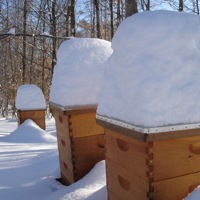The colony that we installed had some trouble initially, but they've been rebounding well over the last few weeks. The colony should be nice and strong by the end of the summer, in time for visits by returning beeschoolers!
Slider



Drone brood


Festooning


Fanning


Lighting the smoker




Capped honey


Brood nest










Harvest


Comb honey




Different types of honey
threeColumn
UVA Bee School is an informal seminar
at the University of Virginia
on the mathematics of honeybee behavior and the practice of
beekeeping. It's part academic pursuit and part social
activity, honoring the University's unique tradition of close
student-faculty friendship. It's led by Associate Professor of
Mathematics Christian Gromoll, and generously supported by the
Mead Endowment.
 Honeybees survive by acquisition, defense, and efficient
allocation of various resources, to enable successful
overwintering and reproduction. This requires
sophisticated decision making, akin to that needed by
manufacturing firms, and beyond the capability of a single bee's
brain. But when each bee follows simple
sets of rules, the aggregate effect creates an emergent
intelligence for the colony as a whole, able to react to a
dynamic environment and achieve complex optimizations.
Honeybees survive by acquisition, defense, and efficient
allocation of various resources, to enable successful
overwintering and reproduction. This requires
sophisticated decision making, akin to that needed by
manufacturing firms, and beyond the capability of a single bee's
brain. But when each bee follows simple
sets of rules, the aggregate effect creates an emergent
intelligence for the colony as a whole, able to react to a
dynamic environment and achieve complex optimizations.
 We're interested in understanding some of the
mathematical principles underlying the colony
intelligence of honeybees. We meet roughly every other
week from October through April to discuss articles
from the scientific literature on honeybees. We also
do some mathematical modeling of specific honeybee
optimization behaviors. Along the way, we learn some
aspects of honeybee biology and ecology, as well as
the history and practice of beekeeping.
We're interested in understanding some of the
mathematical principles underlying the colony
intelligence of honeybees. We meet roughly every other
week from October through April to discuss articles
from the scientific literature on honeybees. We also
do some mathematical modeling of specific honeybee
optimization behaviors. Along the way, we learn some
aspects of honeybee biology and ecology, as well as
the history and practice of beekeeping.
 We're also interested in getting to know each other,
and getting to know the bees. In the Fall and Spring, we
meet regularly at Professor Gromoll's home for
hands-on activities in the apiary. This includes an
opening breakfast in the Fall, and a dinner in the
Spring. We'll also start a new honeybee colony for the
group, and take a field trip to a larger apiary in the
area.
We're also interested in getting to know each other,
and getting to know the bees. In the Fall and Spring, we
meet regularly at Professor Gromoll's home for
hands-on activities in the apiary. This includes an
opening breakfast in the Fall, and a dinner in the
Spring. We'll also start a new honeybee colony for the
group, and take a field trip to a larger apiary in the
area.
01 May 2012
Observation hive
At the beginning of May we finally installed the observation hive. This hive is well ventilated and can hold eight deep frames, in four pairs (only three pairs are currently installed in the photo). So it's big enough to exist as a permanent hive. That is, the frames are permanently behind glass (and also wooden panels when not being observed), as opposed to being placed there temporarily as is done with smaller observation hives. This way we can pop off the panels any time we want, year round, for a glimpse into the status of this honey bee colony. Of course, you can't see in between the pairs of parallel frames. But the two outer sides give a view of half of the entire hive. That's more than enough to see all activities going on inside, and asses the state of things.
Subscribe to:
Post Comments (Atom)

No comments:
Post a Comment